| |
|---|---|
Some Secondary Sex Differences in Humans
1992
Men and women are not equal in abilities. This does not mean that one sex is better than the other, although that may be true for some characteristics. Regarding any one ability or condition, the measure of that characteristic is likely to be normally distributed about a mean. For each sex the means may differ, and the distributions may overlap. For any given characteristic there are very likely individuals of one sex who far exceed the mean for the other sex. For some characteristics the populations may overlap greatly; for others only a little. Here's what the general picture looks like.
|
|
Some anecdotal examples include:
|
PET (positron emission tomography) scans of the brains of volunteers have revealed some sexual differences in brain functioning.
Sing "Row, Row, Row Your Boat". Lift your finger when you come to a four-letter word.
If you're a female, tiny spots on both sides of your brain light up. If you're male, only one side does. That's the kind of map Cecil Naylor of the Bowman Gray School of Medicine saw when she scanned brains of people who had been marked with a radioactive tracer that homes in on active areas. In one task, they listened to words and raised a finger when they heard one four letters long. Women's mental acrobatics were all over the brain; men's were compartmentalized. In women but not in men, some areas associated with vision lit up. "You wonder if females are using more of a visual strategy than males," says Naylor. Perhaps they see the spelled word in their mind's eye and then count letters. [Newsweek, April 20, 1992, p. 70.]The same article reported that meaning is laid down in areas of the brain associated with the sensory mode in which the learning took place. It also suggested that intelligence may be associated with a developed greater ability to more efficiently use the brain's resources. While one might conclude that men use the brain more efficiently in the four-letter task, it could also be that women learned these words in a more visual mode of learning. If both sexes use the same strategy, visualizing the word, the observations support some difference in the efficiency of handling spatial perception, with males processing more efficiently.
In a story about evolutionary approaches to psychology, "Darwin's Minds", Science News Vol. 140 No. 15, October 12, 1991, p. 233-4, Bruce Bower states:
Sex differences in jealousy. "Male jealousy focuses on a partner's sexual infidelity, whereas female jealousy revolves around the loss of emotional commitment from a partner... These differences stem from adaptive differences typical of all mammals... Nearly two out of three men said sexual infidelity would distress them most, whereas 85 percent of the women deemed emotional infidelity the most upsetting."
Sex differences in mating. " Buss' cross cultural study showed that men worldwide preferred younger, physically attractive mates, while women placed greater value on slightly older mates possessing ambition, an industrious nature and good financial prospects. " [David M. Buss, University of Michigan, Ann Arbor] "... this pattern stems from a universal biological constraint... A woman's reproductive capacity declines after her 20s and ends with menopause, but even a man in his 70s retains the ability to father children ... Evolutionary influences on age preferences in mates operate largely outside of consciousness... In industrial societies where women show fewer physical signs of aging, women in their 40s may be more likely to marry younger men" [Douglas T. Kendrick of Arizona State University and Richard C. Keefe of Scottsdale Community College. (to appear in Behavioral and Brain Sciences)]
Facial attractiveness. ... men and women prefer female faces with the childlike features of large eyes, small nose and small chin, the sexually mature features of high cheekbones and narrow cheeks, and the expressive features of a large smile and eyebrows set clearly above the eyes. A full, thick head of hair also increased female facial beauty. 'The ideal female face is young but sexy, friendly but of high social status,' Cunningham concludes. The ideal male face looks much like an ideal female face, with the addition of a larger chin and nose, and thicker eyebrows. Attractive males appear more mature and socially dominate than attractive females. [Michael R. Cunningham, University of Louisville, Kentucky]
In a story about romance entitled Romantic Reverie published in Science News, Vol. 144, No. 22, November 27, 1993, pp. 362-3,5, Bruce Bower writes:
- [David M. Buss of the University of Michigan in Ann Arbor] and colleague David P. Schmitt in the April [1993] Psychological Review indicate that that men approve of casual sex much more than women. p. 363:
- For reproductive success men look for multiple partners; women look for reliable signs of long term commitment and the capacity for economic support or engage in clandestine affairs with many men. Relationships seem to last until the youngest is four. p. 363:
- "... many more men than women report having masturbated...." [Masturbation freshens the stored sperm by getting rid of old ones.] 363,5
- [Male] Masturbation as a first sexual experience associates sexual pleasure with individual pleasure. p. 365.
- [Female] First sexual experience with a partner fosters association of sexual pleasure with the quality of relationships. p. 365
